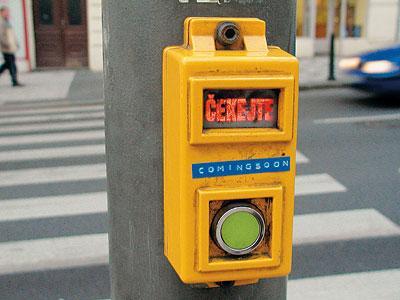| Umělec magazine 2004/2 >> Silvina Arismendi | List of all editions. | ||||||||||||
|
|||||||||||||
Silvina ArismendiUmělec magazine 2004/201.02.2004 Jiří Ptáček | en cs |
|||||||||||||
|
We might approach an explanation of what Silvina Arismedi is doing by describing plate techtonics: “Continental plates are slowly rising, falling, bending and bowing. In places where they impact or crunch together, there arises pressure.” The pressure in the activity of Silvina Arismendi fulfils the shaking of one contextual zone upon another. The resulting epicenter of such seismic activity can be found in a very personal navigation of living space.
Arismendi documents a lot: for example, she photographs all the things that she owns, or photographs plastic bins holding her belongings as she prepared to move. Elsewhere she plugs her ears, walks from her house to a gallery always stopping after the fiftieth step to jot down records on a piece of paper she’s brought with her. The paper and a description of her activities are then put on display in the gallery. During a workshop at the former printing house of the communist daily newspaper, Rudé Právo, she once again gathers up everything related to news. Putting news photographs on slides, she then projects them on a wall. In all cases she essentially creates catalogues. In the catalogue she sets a manner of interaction between their author and the research area. That which we commonly go through as a by-product of the catalogue represents the mental contours and objective of the creator. The visible index of the catalogue is a record of sampled thoughts and pursuance. And Arismendi aims to reveal a concrete process that the contents and its realization would comment on each other. Arismendi is from Uraguay (born 1976 in Montevideo) and it is only since 2001 that she has been attending Prague’s academy of visual art (studio of Vladimír Skrepl). Maybe that is why the greater part of her work concerns movement and relocation. In an untitled video from 2003, she asks questions of Latin American students who were preparing for college admissions exams in Bohemia. In a recent series of photographs, for a change she decorated Prague streets with Palms. As such she did not just cross two vague regions as both contain peculiar social and experiential horizons, through which her work changes depending on who follows her montages. The reaction to the meeting of two distinct referential systems would be different for a Uraguayan, just as it would for a native Czech, a well-traveled adventurer or a local loaf. We might find more in her operations with texts that she realized with the assistance of a Dymo office stamper. She used their characteristic green strips intended for inventory motifs for office property, and she put them up in interiors and exteriors. While these signs evoked bureaucratic information, the contents instead contained emotional slogans set in unlikely situations (a “Coming Soon” advertisement was set under the Wait signal of an electric intersection crossing), or the technicist variations of subcultural communication (Punk Is Not Dead). She calculated that there’d be the same sort of surprise if she had hung pictures amid the city’s exterior. She upturned ideologies that we use to symbolize public space, be them official (urbanism, facades, etc.) or unofficial (street art). As to other ideologies, she expressed herself by crumpling up a map of the world into a ball. A map of the world – a concept of the world was, through a game, to the third demension, and in reverse, revealed as a geographic fiction.
01.02.2004
Recommended articles
|
|||||||||||||











Comments
There are currently no comments.Add new comment